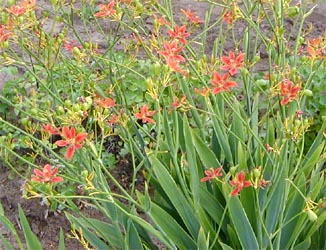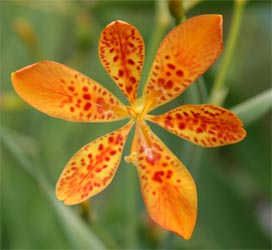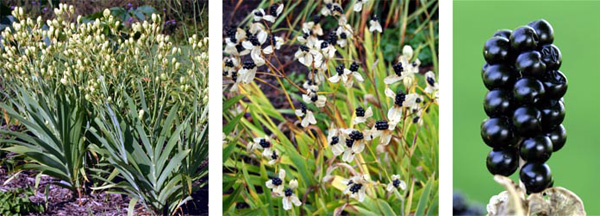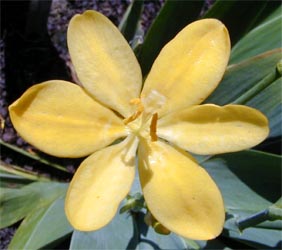
Blackberry lily, also referred to as leopard lily and several other common names, is a short-lived perennial native to eastern Russia, China and Japan. The dried rhizome has long been used medicinally in Eastern Asia for a variety of ailments.
This plant is not a true lily, but is a member of the iris family (Iridaceae) with the name Belamcanda chinensis. However, recent evidence suggests it is more closely related to Iris, and should actually be placed in the genus Iris. Because of taxonomic priorities, the name I. chinensis is already taken and the new name of I. domestica was proposed in 2005 (see box to the right for a detailed explanation), but the old name is still in general use. Forms with pure yellow flowers are sometimes listed as another species, B. flabellate, but there is only one recognized species in the (former) genus Belamcanda. Despite the fact that some reputable references suggest it is hardy only in zones 8-10, it survives and flowers reliably in zone 4.
A New Name for Blackberry Lily
As a result of DNA sequence evidence, Peter Goldblatt and David Mabberley proposed a new name for this species in 2005, published in the journal Novon 15: 128: Iris domestica.
“The eastern Asian genus Belamcanda (Iridaceae: Irideae), with its sole species, B. chinensis, the leopard or blackberry lily, has long been understood to be most closely related to Iris dichotoma (syn. Pardanthopsis dichotoma), but has nevertheless been maintained as a separate genus because of its distinctive floral, fruit, and seed morphology. Molecular DNA sequence evidence shows B. chinensis and its sister species, I. dichotoma, to be nested within the large Northern Hemisphere genus Iris (ca. 280 spp.). Not only does consistent taxonomic treatment of genera of the Iridaceae require that Belamcanda be transferred to Iris, but we argue that taxonomy should follow the principle of monophyly, which requires that Belamcanda and any other genus nested in Iris be treated as members of that genus. A new combination, I. domestica (basionym Epidendrum domesticum), is made for B. chinensis (based on Ixia chinensis), because the name Iris chinensis is preoccupied. The names Belamcanda pampaninii Léveillé and B. chinensis var. taiwanensis S. S. Ying are here included in the synonymy of I. domestica.”

Regardless of its correct botanical name, this plant is very similar in appearance to an iris plant, with flat, sword-like leaves arranged in a fan on a small tuberous rhizome. The foliage grows to 18” tall and the plants produce many offsets. The flowers, however, are very different in appearance from typical iris flowers. They are borne on 2-3 foot tall slender stems in loose, branched spikes. The tall flower stems sometimes flop or are blown over in strong winds, so they may benefit from staking. The flowers are 2” wide with 6 flaring petals of equal size. Flower color in the species ranges from yellow to orange, with darker (often crimson) speckles on the petals. Individual blooms are short-lived – generally lasting only a day – but the plants produce a succession of flowers over a period of several weeks in summer.
The flowers are followed by pear-shaped seed capsules that fade from green to tan. These eventually open to reveal the round, shiny black seeds arranged in clusters resembling large blackberries that give rise to the common name. The seeds remain on the stalks for several months. When left standing, the seed heads offer good winter interest, especially when viewed against a backdrop of snow. The seed heads are also a unique addition to dried flower arrangements.

Grow blackberry lily in full sun or light shade. It prefers well-drained, moderately fertile loamy soil, but does just fine in sandy or clay soils. It will be shorter when grown in poor, dry soil, and taller if the soil is rich and moist. Deadhead to prolong blooming (and prevent self-seeding). Even in colder climates it does not need winter protection.
The flowers and the seed heads are interesting, but not particularly showy so this species is best planted in a location where they can be appreciated up close. Before the plants begin flowering they are not especially eye-catching, so you may wish to mix it with other plants that can attract attention until the blackberry lily begins flowering. It is suitable for perennial borders, in containers, and for naturalizing in an informal area.

This perennial plant is easily grown from seed, and will flower the first season if started early enough. Sow the seed ¼” deep in warm soil (indoors in pots 6-8 weeks before planting outside or in the garden after the danger of frost has passed). Keep the seedbed evenly moist and germination should occur in 1-2 weeks. Seedlings are easily transplanted. This species can also be propagated by division in spring or early autumn.

Blackberry lily will also self-sow enough to be considered invasive, particularly in eastern North America where it has naturalized in some locations. In Wisconsin, the only place it has spread is on dry prairies, so do not to plant it near prairie remnants. The seedlings are easy to identify and are not difficult to remove, so it can be managed without much difficulty. Remove the flower stalks before the seed pods mature if you wish to eliminate reseeding (and are not counting on the ornamental interest of the opened seed pods).
The species is generally available only as seed, but sometimes plants are offered for sale. There is only one cultivar generally available. ‘Hello Yellow’ is a yellow flowered selection with a neat, compact habit. It grows 18-24” tall and is relatively slow growing.
– Susan Mahr, University of Wisconsin – Madison





 Aster, Symphyotrichum spp.
Aster, Symphyotrichum spp. Fascinating Fasciation
Fascinating Fasciation Alternatives to Lawn: Groundcovers
Alternatives to Lawn: Groundcovers Marigolds
Marigolds


